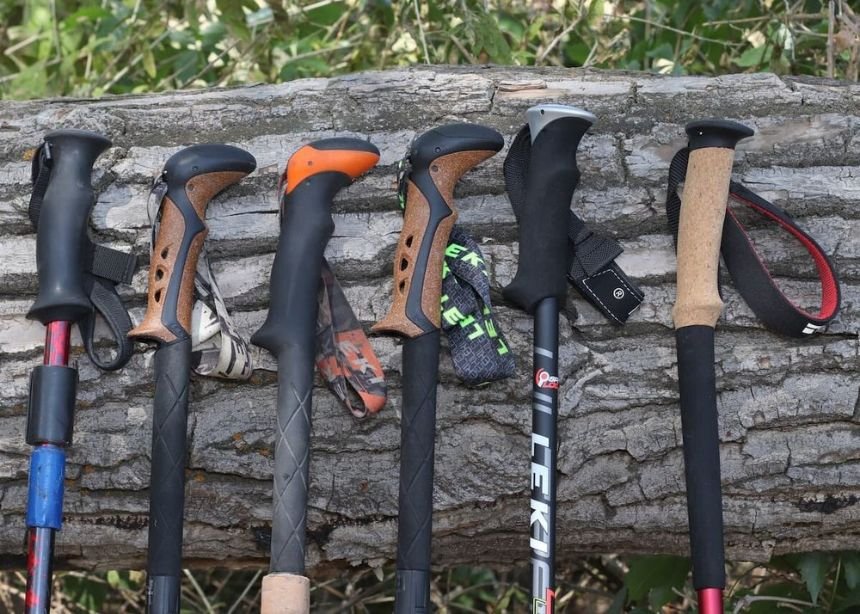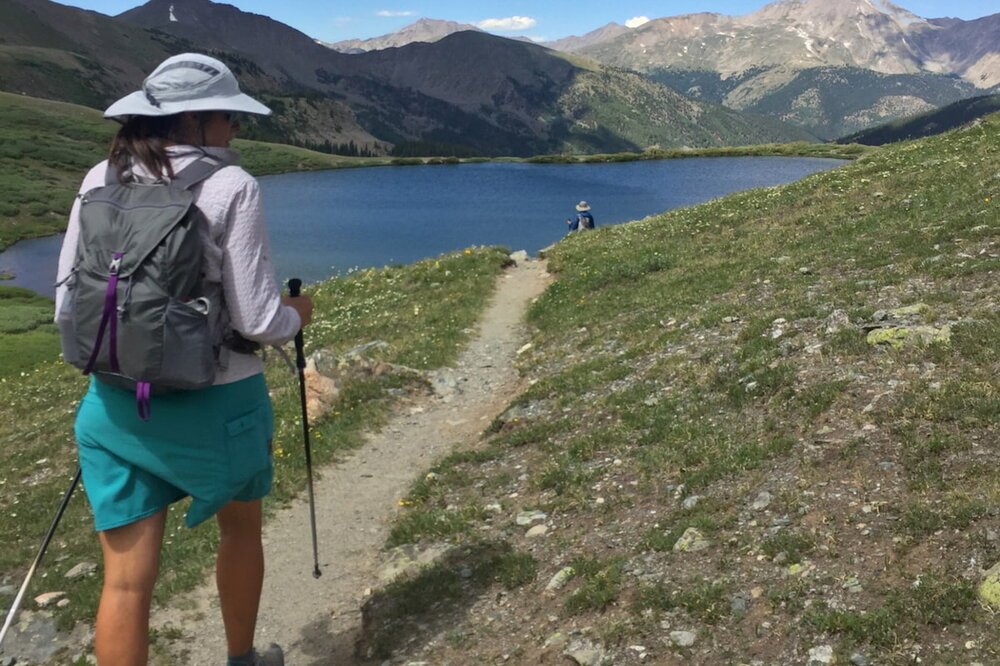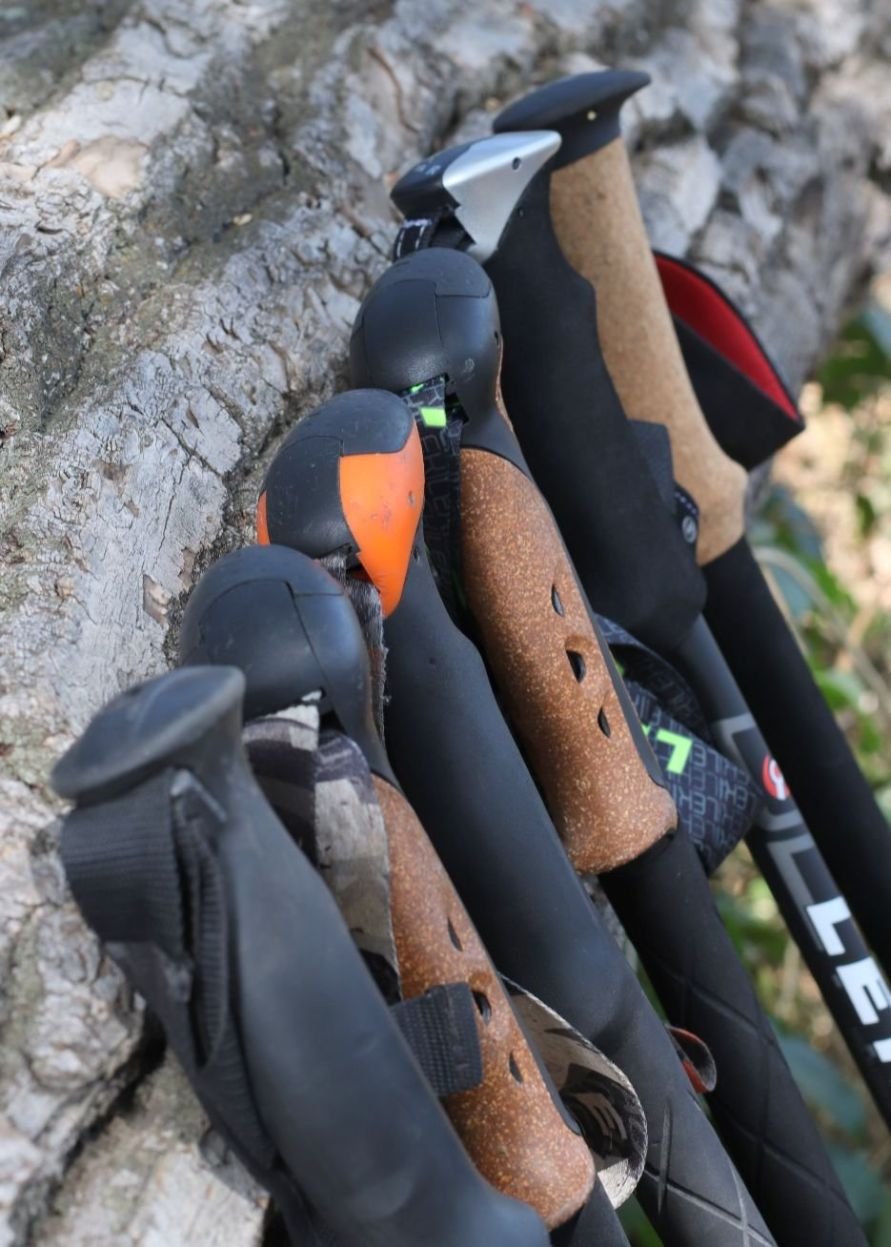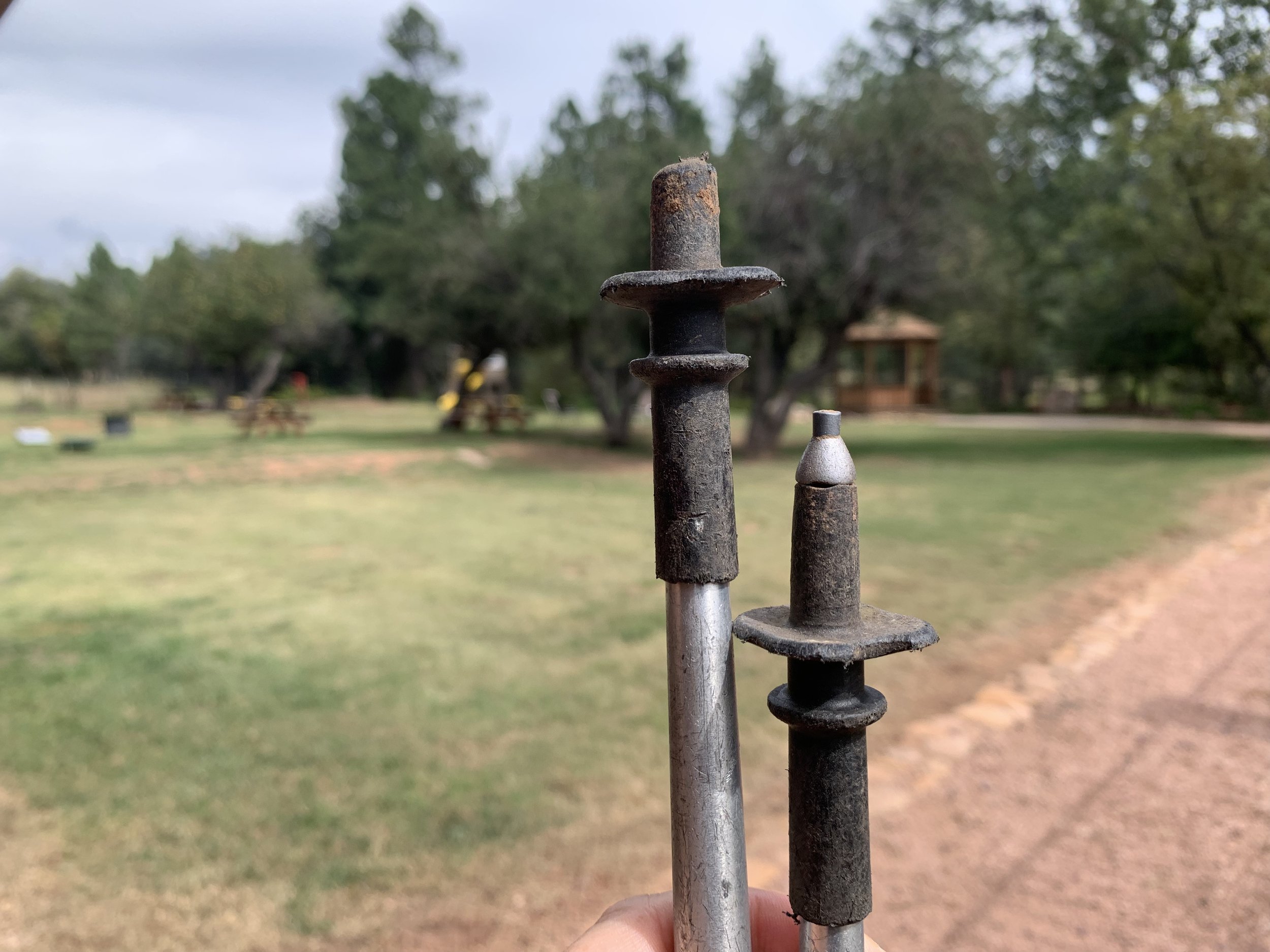How to Choose Trekking Poles
find the right hiking poles, staff, or stick for on and off-trail hiking & backpacking trips
Some of the trekking poles we tested for our Best Trekking Poles guide. Photo by John Carr.
March 24, 2024
Home > How to Choose Gear
Trekking poles have increased in popularity among day hikers, backpackers, and even trail runners – for good reasons. Trekking poles can reduce the impact on your feet, ankles, knees, and hips. They provide stability on rough terrain and help with stream crossings. They can even be used in lieu of tent poles!
And with this explosion of popularity, manufacturers have responded by adding more and better features. That means choosing the right trekking poles can be a daunting task. It can be hard to know where to begin based on your style of hiking, body, and hiking destination.
This article will help you choose the best trekking poles (or hiking staff) for your needs. From there, head on over to our Best Trekking Poles for models we recommend and why.
Related: The Top 14 Reasons to Use Trekking Poles
We create reader-supported, objective, independently-selected gear reviews. This story may contain affiliate links, which help fund our website. When you click on the links to purchase gear, we may get a commission, without costing you an extra cent. Thank you for supporting our work and mission of outdoor coverage for every body! Learn more.
Treeline Review writer Felicia Hermosillo with trekking poles on a day hike in Colorado.
TYPES OF HIKING POLES
There are two main types of walking poles: trekking poles and hiking staffs. Both have different advantages, as we discuss below.
Trekking Poles
Trekking poles are usually (but not always) sold in pairs and are meant to be used as a pair. They are usually (but not always) adjustable length-wise. Trekking poles are, by far, the most popular option.
Trekking Pole Advantages:
When used properly, you'll always have 2 points of contact with the ground
You usually need 2 poles if using as tent poles
Most of our testers report using two trekking poles at once feels more natural and helps keep an more even stride
Hiking Staffs
A hiking staff, sometimes called a walking staff or walking pole, is sold individually. As with trekking poles, most hiking staffs are adjustable in length. Some hikers and backpackers prefer to keep one hand free while hiking, especially if they frequently take photos with a camera, navigate with a phone, use an umbrella, or eat snacks while walking. Many hiking staffs also have a camera mount and act as a monopod for those who use cameras instead of phones for taking photos outdoors.
Hiking Staff Advantages:
Less weight in your pack when you aren't using it
Keeps one hand free for your camera, water bottle, or umbrella
A Z-style folding pole is one of the ways that trekking poles can fold. Photo by John Carr.
FOLDING STYLE
Trekking poles come in four styles: folding, telescoping, combination, and fixed.
If you intend to travel with your trekking poles, you won’t want to keep them at their full length. While TSA Guidelines suggest you can’t fly with trekking poles in your carry-on anymore, they can be checked in a suitcase or backpack.
Folding, telescoping, and combination poles have advantages over fixed-length poles. It is likely there will be conditions on your hike when you will want to put your poles away. For example, if you need to use your hands for scrambling around steep terrain, carrying an ice axe, or using an umbrella. On cold mornings, some hikers prefer to keep their hands in their pockets instead of using trekking poles. Folding, telescoping, and combination poles allow you to easily carry your poles strapped to your hiking day pack or your backpacking backpack.
Lastly, folding, telescoping, and combination poles are the best option for folks doing multi-sport activities. For example, bikepackers or packrafters who add a hiking component to their trip. For multi-sport athletes, we recommend poles the shortest poles you can find. You will want a pole that can easily fit on your bikepacking bike or packraft. In our experience, the Black Diamond Distance Carbon FLZ folds down to the smallest size at 34 cm (size small) or 40 cm (size large).
Folding Trekking Poles
Folding poles disassemble into a z-shape and often have a cable connecting all the parts together, much like tent poles.
Advantages of Folding Trekking Poles:
Collapse down much smaller than telescoping poles
Usually weigh less than telescoping poles
Disadvantages of Folding Trekking Poles:
They cannot bear as much weight as telescoping poles
The adjustment range is less than telescoping poles
They may not be long enough to use as your tent pole
They are often more expensive
Folding Poles are Best For:
When weight is critical
Trail running
Scrambling and climbing
Ultralight backpacking
When you need to take your trekking poles on a plane
Telescoping Trekking Poles
Telescoping poles press into themselves. They usually have two or three sections with a locking system to keep the sections in place. The locking mechanisms are either a twist lock or a lever lock.
Advantages of Telescoping Trekking Poles:
They're stronger than the folding style
The shaft usually is larger than folding poles, which increases strength and durability
A wider range of adjustment length
They're usually long enough to use as your tent pole
They're easy to adjust for uphill or downhill terrain
Usually less expensive than folding poles
Disadvantages of Telescoping Trekking Poles:
Not as compact (more difficult to pack)
Slightly heavier than folding styles
Telescoping Poles are Best for:
Hiking
Backpacking
When you're using your trekking poles as tent poles
Combination Trekking Poles
Combination trekking poles have one telescoping section and two folding sections. We think combination poles are the best of both worlds.
Advantages of Combination Trekking Poles:
More adjustment length than folding poles
Easy to adjust the length on the fly
More durable than folding poles
Disadvantages of Combination Trekking Poles:
Less adjustment length than telescoping poles
Slightly heavier than telescoping poles
Less durable than telescoping poles
Combination Poles are Best for:
Hiking
Backpacking
Fixed Length Poles
A fixed length pole is not adjustable, similar to a ski pole. In fact, some hikers use ski poles as trekking poles because they can usually be found at thrift stores.
Fixed length poles vary from wooden walking sticks to old ski poles to high-end carbon poles. Our editors have used high-end fixed-length trekking poles and find they offer substantial weight savings but only provide real benefits if used on flat ground.
Advantages of Fixed Trekking Poles:
No moving parts to break
Depending on the material, it may be the strongest of all the styles of trekking poles
High-end models will be lightweight because they don’t have weighty levers
No locking components to break or get stuck
Disadvantages of Fixed Length Trekking Poles:
Difficult to pack when you don't want to use them
Can't adjust the length based on uphill or downhill terrain
Will likely need a pole extender to use as your tent poles
Fixed Length Poles are Best for:
When weight or cost are your only consideration
See our most popular hiking articles or see all our Hiking Gear Guides:
Lever locks and flick locks are our preferred locking mechanisms on trekking poles. Photo by John Carr.
LOCKING MECHANISM
On adjustable trekking poles, the locking mechanism keeps the pole at the length you set and keeps the pole from collapsing when you put weight on it. There are two types of locking mechanisms: lever locks and twist locks.
Lever Locks
Lever locks open to allow for a change in length, and the lever closes when you’re finished. The most recent generation of lever locks is extremely reliable and easy to use. Look for aluminum lever locks, rather than plastic, for long-term durability.
Advantages of Lever Locks:
Strong
Durable
Easy to use
Disadvantages of Lever Locks:
Heavier than twist locks
Lever Locks are Best for:
All uses except when weight is your only concern
Twist Locks
Twist locks turn to loosen the lock so that you can adjust the length. Twist locks tend to loosen too much and fail over the life of a trekking pole, and as primarily internal mechanisms, they are difficult to fix. All of our testers prefer lever locks.
Advantages of Twist Locks:
Lighter than lever locks
Disadvantages of Twist Locks:
Unreliable and may collapse when you need support the most
The mechanism is prone to break and is difficult to fix
Twist Locks are Best for:
When weight is your only concern
Close up of a push button lock on a Leki trekking pole. Photo by John Carr.
Push Button Locks
Push button locks use a button to lock or release the length of the pole. Push button locks are most often found with Z-style folding poles. Push button locks have a learning curve and require some arm strength. However, they can be faster and easier to lock than twist locks. Push button locks are primarily internal mechanisms, so can be difficult to fix.
Advantages of Push Button Locks:
Faster to adjust than other systems
Lighter than lever locks
Disadvantages of Push Button Locks:
Often more expensive to use than other locks
The mechanism is difficult to fix
Push Button Locks are Best for:
Trails and routes with rock scrambling where you need to use your hands, put away your poles, and then use your poles again when the scrambling is over.
Trails where you want to quickly put away your poles and access them again, such as when using an umbrella or ice axe
Two push button poles by the same manufacturer. The one on the left is carbon and the one on the right is aluminum. Photo by John Carr.
POLE MATERIAL
Trekking poles are generally made from aluminum, carbon fiber, or a combination of aluminum and carbon fiber. Trekking pole material is the largest contributor to weight. Hybrid poles are made of both aluminum and carbon fiber and attempt to capture the best features of both materials.
Aluminum Trekking Poles
Aluminum is heavier and more durable than carbon fiber and is less likely to break with rough use.
Advantages of Aluminum Poles:
More durable than carbon fiber
Aluminum can bend, but it is unlikely to break
Less expensive than carbon fiber
Aluminum poles often come with the best warranties
Disadvantages of Aluminum Poles:
Heavier than carbon fiber
Aluminum Poles are Best for:
People on a budget
People who are using a baby and child carrier backpack
People who are hard on their gear
Long-distance backpackers who use their trekking poles as backpacking tent poles (where a broken pole would be problematic)
Hiking in rugged terrain
Carbon Fiber Trekking Poles
Carbon fiber poles are significantly lighter than aluminum poles. That lighter weight comes with a price, however – durability.
Advantages of Carbon Trekking Poles:
Lighter than aluminum
Disadvantages of Carbon Trekking Poles:
More likely to break than aluminum under stress
More likely to crack or chip than aluminum
Potentially sensitive to cold temperatures
More expensive than aluminum poles
Carbon Poles are Best for:
Ultralight hikers, backpackers, fast packers
Trail runners
You’re out for a short day hike
Where weight is a primary concern
You're gentle on your gear
Grip Material
Trekking pole grip shapes from ergonomic grips to extended grips. Photo by John Carr.
Cork, foam, and rubber are the three main hiking pole grip material.
Cork Grips
Some hikers prefer cork grips for their comfort – they can form to your hands over time.
Advantages of Cork Grips:
Mild shock-absorption properties
Sweat-wicking
Conforms to your hands over time
More durable than foam
Disadvantages of Cork Grips:
Can develop an odor over time
Can be slippery on hot summer hiking trips
Cork Grips are Best for:
All-around performance and durability
If your hands sweat a lot
Hiking in hot weather
Foam Grips
EVA foam grips are the lightest option. Many people prefer the feel of foam over cork or rubber.
Advantages of Foam Grips:
Lightest of the three grip options
Very comfortable and soft to the touch
Disadvantages of Foam Grips:
Absorb sweat
Least durable of the three grip options
Foam Grips are Best for:
Comfort
When weight is your primary concern
Rubber Grips
Rubber grips are the least expensive option but compromise on performance.
Advantages of Rubber Grips:
Least expensive of the three grip options
Most insulation properties of the three grip options
Disadvantages of Rubber Grips:
Don't absorb sweat or water
Because they don't absorb sweat, they are most likely to cause blisters or chafing
Heaviest of the three grip options
Least comfortable of the three options
Rubber Grips are Best for:
Cold weather sports (e.g., snowshoeing, mountaineering, skiing)
Hiking or backpacking in rainy conditions
Trekking poles come in cork, rubber, and foam models. Photo by John Carr.
GRIP SHAPE AND LENGTH
The shape and length of the grips on your trekking poles can affect the strain and comfort on your wrists and hands – especially over long distances or multi-day trips. Here's what to look for.
Ergonomic Grips
Ergonomic grips are shaped to match the contours of your hands. In addition, some grips are angled such that your wrists are in a neutral position rather than bent. Some grips are even further contoured for left and right hands to reduce pronation.
Comfort is subjective, so the choice of grip comes down to personal preference. We know hikers from both extremes – die-hard fans of Pacer Poles, and people who prefer straight shafts with no ergonomics.
Advantages of Ergonomic Grips:
They’re extremely comfortable
They can reduce fatigue over long periods of time
Disadvantages of Ergonomic Grips:
Can be slightly more expensive
May not fit all hand sizes and shapes
Ergonomic Grips are Best for:
Most people and situations
Extended Grips
Some trekking poles have grip material (cork, foam, or rubber) that extends further down the shaft. This extension makes it easy to switch positions when needed, such as a short but steep section of trail.
Advantages of Extended Grips:
More versatile
Easy to change hand placement without having to change the length of the pole
Disadvantages of Extended Grips:
Add to the weight of the pole
Extended Grips are Best for:
Rugged or technical terrain
Steep terrain
When you'll use your poles for a wide variety of activities or terrain, such as on a thru-hike
Learning the proper way to use wrist straps can help optimize the benefits of using trekking poles. Photo by John Carr.
WRIST STRAPS
Wrist straps are an essential part of trekking poles. When properly used, they reduce strain on your hands by reducing the squeezing power needed to grip the poles. Comfort is key here – you want the wrist strap material to be soft yet durable to reduce the possibility of chafing.
The proper way to use wrist straps is to raise your hand from underneath the strap. Once your hand is through the strap, bring it back down slightly onto the strap and the rest the side of your hand and wrist on the strap. Then grip the pole with your hand (but not too hard).
The material used for wrist straps varies among manufacturers. Personal preference is paramount here. If the strap material isn't comfortable, then you likely won't use the straps at all. Test before you buy to see what works for you.
If you have sensitive skin, look for wrist straps with a soft fabric and padding.
WEIGHT
The biggest contributor to the weight of trekking poles is the shaft material – aluminum or carbon fiber. A lighter weight pole does have benefits, especially when compounded over long miles. Ultralight poles are easier to swing, and therefore you'll experience less fatigue than with heavier poles. On the other hand, heavier poles will feel sturdier and more durable.
Lightweight hiking poles are best for:
Fast packing
Backpacking
Heavier hiking poles are best for:
If you're rough on your gear
You tend to put a lot of weight on your poles
You're carrying a heavy load
You’re hiking in snow or rugged terrain
WOMEN’S TREKKING POLES
Some manufacturers make a women's version of their trekking poles. The main difference between the unisex and women’s versions is the maximum length, weight, and grip size. Smaller hands will appreciate the smaller diameter grip. And if you don't need the length, why carry the extra weight? In fact we know many men who opt for women’s trekking poles for the weight savings.
However, if you plan on using your trekking pole as a tent pole, the shorter length may not be sufficient.
women’s poles are Best for:
People looking for the lightest trekking poles possible
People with smaller hands
People who don't need a long trekking pole
People who are not backpacking (like day hikers and campers)
Backpackers who don't use their trekking poles as tent poles
SHOCK ABSORPTION
Some manufacturers sell trekking poles with shock absorption properties. A system including a small spring, located in one of the joints or near the tip of the pole, purports to reduce impact and vibration on the downhill.
However, all of our testers agree that shock-absorbing poles have serious drawbacks. They tend to make uphill travel harder, make poles weightier, cost more, and have more moving parts that can fail. But most of all, they really don’t do much.
Advantages of Shock Absorbing Trekking Poles
Minor increase in comfort
Disadvantages of Shock Absorbing Trekking Poles
More expensive than standard trekking poles
Weigh more than standard trekking poles
The shock mechanism isn't durable
shock absorption is Best for:
People with weak ankles or knees
Adjustability
Most trekking poles are adjustable in length, allowing you to customize them to your height and the terrain. For example, your poles may need to be longer going downhill and shorter going uphill. Look for poles with easy-to-use locking mechanisms, such as twist locks or lever locks, that securely hold the poles in place while hiking.
PRICE
A great pair of trekking poles will meet all of your needs for function while also fitting into a reasonable budget. With some exceptions, a great pair of trekking poles generally cost between $50 and $200.
Though there are exceptions, our analysis of consumer reviews indicated that most trekking poles under $50 have flaws that lead to cracking, bending, snapping, or unexpected collapse. And while other models can cost $200 or more with shipping—including the Gossamer Gear LT5 poles, which won for Best Ultralight Trekking poles—we think that the small decrease in weight isn’t worth the large increase in price for most hikers.
REPLACeable Carbide Tips
Poles with replaceable carbide tips can significantly extend the life of your investment. If your tips break, it doesn't mean your poles are done for. In fact, replacing tips is a normal part of hiking pole ownership, much like replacing tires on your car.
We highly recommend choosing poles with replaceable tips.
Trekking pole baskets, rubber tips, and other accessories can make your trekking poles work better for you based on the environment. Photo by John Carr.
ACCESSORIES
Most trekking poles have optional accessories, which will expand the usage range of your trekking poles into winter and urban environments.
Snow BASKETS
Look for trekking poles with optional interchangeable baskets for snow and mud. If you plan on hiking through snow, we highly recommend bringing snow baskets. Without them, your poles will become almost useless. As you apply pressure, your hiking stick will simply sink into the snow and throw you off balance.
RUBBER TIP
Rubber tips are a must if you plan on using your poles for Urban Hiking or nordic walking. Rubber grips to cement and pavement (which is essential for nordic walking poles), whereas metal pole tips will scrape and have little traction on harder surfaces.
Rubber also can provide better grip in certain situations in the backcountry and keep your poles from scarring the rocks. Indeed, many Leave No Trace experts believe that rubber tips are better for the trail.
WHY YOU SHOULD TRUST US
I personally have hiked over 3500 miles, including thru-hikes of the Pacific Crest Trail and Colorado Trail and a LASH (long-*ahem* section hike) of the Grand Enchantment Trail. Between those hikes and a stint as a Traveling Trainer for the Leave No Trace Center for Outdoor Ethics, I've slept outside for nearly a year of my life.
Whether it's living on the road or living out of a backpack, traveling and just being in the outdoors is second nature to me. I’m an American Hiking Society Next Generation Trail Leader and a board member at the American Long Distance Hiking Association-West, which awards the Triple Crown of Hiking. I run the popular blog Brown Girl on the National Scenic Trail, a space for intersectional writing to encourage folks of all colors and all walks of life to experience our wild spaces and preserve them for the future.
You can read all of Amanda’s stories on her author page.














